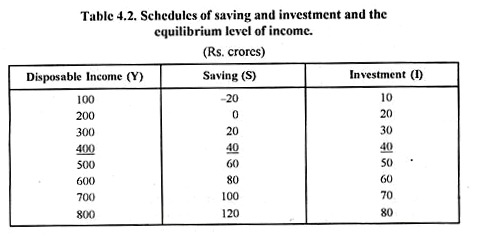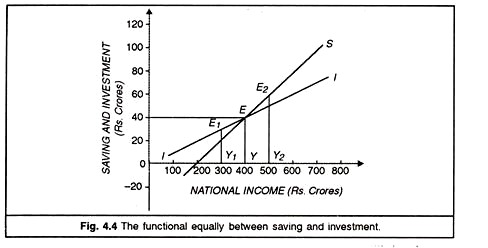Let us make an in-depth study of the Saving and Investment Equality:- 1. Subject-Matter 2. The Classical Position 3. Saving Always Equals Investment (Accounting Equality) 4. Accounting Equality is Useful 5. Saving Equals Investment only in Equilibrium (Functional Equality).
Saving and Investment Equality # Subject-Matter:
An important print of the controversy between Keynes and classics was the saving investment equality.
In Keynes’ ‘General Theory’, saving and investment equality is derived from the general equality of aggregate demand and aggregate supply (Y = C + I) Equilibrium in the economy is arrived at when total demand in the economy is equal to aggregate supply. Another name for this Y = C + I is the equality between saving and investment.
Prof. Hansen remarks that there are two Keynes involved in the matter of saving and investment equality in the ‘General Theory’-one ‘apparent Keynes’ and the other ‘real Keynes’. We have seen that the economy is in equilibrium only when saving (in exposit or realised sense) is equal to investment (in the ex-post or realised sense), i.e. S = I. This is what we may call real Keynes. But Keynes also defined saving and investment in such a way that they are always equal S = I. This is what we may call apparent Keynes.
ADVERTISEMENTS:
At some places, in his ‘General Theory’, Keynes says that saving always equals investment. At other places, he writes that saving equals investment only in equilibrium. This double meaning and dual approach to equality between saving and investment has been a source of great confusion for many writers and readers. The equality between saving and investment has been the cause of great debate and controversy on account of the differences of opinion on the definitions adopted by different economists of saving and investment.
The main source of confusion arose from the failure of the critics to realize that while saving and investment are always equal, they the not necessarily in equilibrium. If the economy is in motion and the variables are always in a normal functional relationship to each other, then saving and investment are not only equal but may also be in equilibrium. But if the process of change involves lagged adjustment of certain variables, this will not be the case. For example, if there are consumption-expenditure production lags, saving and investment though equal will not be in equilibrium. There can be no equilibrium position unless lags have worked through, once lags have been overcome or worked through, saving and investment are both equal and in equilibrium.
Saving Investment Equality # The Classical Position:
Keynes was not the first to note the importance of the equality between saving and investment. Classical economists also talked of saving and investment being equal to each other. There are, however, important differences between classical and Keynes. Firstly, classical believed that saving and investment equality is brought about by the rate of interest. When saving tends to exceed investments, the rate of interest falls to discourage savings on the one hand and encourage investment on the other.
Similarly, when investment exceeds saving, rate of interest rises to discourage investment to increase saving. Thus, the disequilibrium between savings and investment is corrected by changes the rate of interest. Secondly, Classical believed that this equality between saving and investment is always brought about at full employment income.
ADVERTISEMENTS:
Both these propositions have been questioned by Keynes. Instead, he held the opinion that the equality between saving and investment is brought about not by the rate of interest, but by changes in income. As and when investment exceeds savings, increased investments (through multiplier) must increase the aggregate income of the community to such a level that the increased saving out of the increased income is equal to increased investment.
Thus, income change is the mechanism through which the equality between saving and investment is established. Further, the novelty of Keynes’s approach to saving and investment equality lies in the belief that they can be equal at less than full employment.
Saving and Investment Equality # Saving Always Equals Investment (Accounting Equality):
Keynes defined saving and investment in such a way that in his theory, saving always equals investment. This is called accounting equality. Accounting equality between saving and investment is also called logical identity. The logic behind this equality is as under.
The national output consists of (i) consumption goods, (ii) investment goods, (O = C + I). In the same way, national income is divided between consumption expenditure and saving (Y = C + S). But we know that by definition O = Y, therefore, C + I = C + S or I = S.
ADVERTISEMENTS:
This equality between saving and investment can be expressed in another way also: for example, Keynes defined savings as the excess of income over consumption, i.e., S Y C. Further, investment is the name given to expenditures other than the consumption expenditures, it is nothing but income minus consumption or I= Y- C. Hence S= I (because both are = Y – C).
Saving and Investment Equality # Accounting Equality is Useful:
(i) It helps us to explain the ‘paradox of thrift’, i.e., if all people living in the community try to save more, the total or aggregate saving will not rise. This identity reminds us that one man’s saving is another man’s reduced income, i.e. when one man saves more in the community; it means somebody else’s income is being lowered. Thus, the community’s attempt to save more without total increase in the income of the community would prove futile. This is the famous ‘paradox of thrift’.
(ii) The identity (S = T) further points to the unfavorable results that flow from an attempt to save more than investment at a particular time. Both saving and investment at a particular time are equal to Y- C; therefore, failure to spend more on the part of one man means the failure to earn more income on the part of another. This happens because a man is able to increase his saving, only by curtailing his consumption, which leads to a decline in effective demand and hence income and employment. This is an important implication of S and I identity.
Saving and Investment Equality # Saving Equals Investment only in Equilibrium (Functional Equality):
Keynes made it known clearly that the equality between saving and investment is brought about by the changes in the national income (and not by the rate of interest as stressed by the classicals). Let us see what happens when investment exceeds saving (by Rs. 20 crores) at a certain level of income (say Rs. 100 crores). This will increase national income through multiplier to such an extent that savings out of the increased income would be equal to the investment (or the excess of investment, i.e., Rs. 20 crores).
Let us suppose that S = I when income (Y) is Rs. 100 crores. Let us suppose further that consumption (Q is Rs. 80 crores and investment (i) Rs. 20 crores, which is equal to saving (Rs. 20 crores). Suppose the multiplier (K)= 2. Suppose further that investment increases by Rs. 20 crores and the total investment becomes equal to Rs. 40 crores (i.e., ∆1 by Rs. 20 crores). This will generate a multiplier effect and give us increased income of A7 = K AIRs. 40 crores (∆Y (40 crores) = K(2) x ∆I].
Thus, the total national income will rise from Rs. 100 crores to Rs. 140 crores, and out of this increased income of Rs. 140 crores, increased savings of Rs. 40 crores will flow (which are equal to increased investment of Rs. 40 crores). This will happen because the initial increase in investment (by Rs. 20 crores) will go to increase business activities in the capital goods industries, where more people will be employed.
Their incomes will increase leading to a rise in the demand for consumption goods. This will result in more income and employment in the consumption goods industries, leading to a multiplier or cumulative rise in the total national income of the community, making it possibly for the increased savings to flow (which are equal to increased total investment i.e., Rs. 40 crores.) It is in this sense we say that savings depend upon changes in income.
Therefore, by functional equality of saving and investment, we mean that both savers and investors, though they are quite different persons having different motives, act and react to income changes in such a way that their desires to save and invest get reconciled in the very process of their actions and reactions. Thus, we can easily conceive of a functional relationship between saving and national income on the one hand and investment and national income on the other.
In this manner, saving schedule indicates various amounts of saving corresponding to different levels of national income and the investment schedule represents the various amounts of investment corresponding to different levels of national income. However, there is some unique level (equilibrium level) of national income at which savings calculated from the saving schedule are equal to investment calculated from the investment schedule. This is known as the functional equality of saving and investment and this is shown in the table and diagram as follows.
We have shown the figures of the table given above in the diagram 4.4. National disposable income is shown on the X-axis. The saving schedule is SS. The investment schedule is II. If we examine the figure, we find that Rs. 400 crores (OY) is that unique level of national income at which saving EY (Rs. 40 crores) is equal to investment EY (Rs. 40 crores), and which represents functional equality S and I.
This is also called equilibrium level of income; because of here national income is neither rising nor falling (i.e. S -1 = 0). The economy is in disequilibrium in the diagram when the national income is Rs. 300 crores (OY1) because investment is greater than saving by Rs. 10 crores. Therefore, income must rise from OY1 to OY so that savings increase from Rs. 20 crores to 40 crores and are made equal to investment. Similarly, at income of Rs. 500 crores (OY2), savings (Rs. 60 crores) exceed investment (Rs 50 crores) by Rs. 10 crores. Therefore, income must fall from Rs. 500 crores (OY2) to Rs. 400 crores
(OY) so that savings are equal to investment at Rs. 40 crores at the equilibrium income level of Rs. 400 crores. This, however, does not mean that this income (OY) is a full employment equilibrium income or a full employment level of income i. e., S and I are equal, does not mean that there is necessarily full employment in the economy.
ADVERTISEMENTS:
It only means that S and I are and can be, equal at less than full employment (popularly called underemployment equilibrium). Classicals would call is a disequilibrium situation of the short period. But Keynes called it an equilibrium of the economy at a point of less than full employment.

